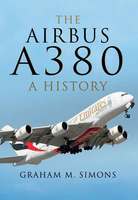When I got this book about the Airbus A380 in my hands, I noticed that it had been written by the same author as the book about the Comet: Graham M. Simons and that guarantees a book which thoroughly deepens the topic with a lot of technical details and even more beautiful pictures… I was not disappointed.
The book starts off with the prehistory of the A380, namely the intercontinental transport of passengers in the pre- and after-war years (1935-1950) of aviation. With the building of the Hughes Hercules – a gigantic flying boat driven by 8 engines – Howard Hughes wanted to prove in that time that the bigger the means of transportation was, the more efficient the passengers could be transported. Unfortunately the Hercules was no success, but the seed for the later development of the nowadays A380 was laid.
The first double decks passengers planes were already built around 1950 by the French and the Americans and came forward from the military transport planes. In the 60’s the first wide bodies came into productions, like the military Lockheed Galaxy, the Lockheed TriStar, the Douglas DC-10 and the big civil success the Boeing 747. Till so far the dominancy of the Americans on the civil plane market. But then the Airbus starts to stir with the introduction of the Airbus A-300, which made its first flight on the 28th of October 1972 and became a commercial success partly due to a big commission of Eastern Airlines.
The next part of the book describes the researches that lead to it that Boeing and Airbus decided to step into the market of the super wide bodies. As a red thread in this period plays the controversy between Boeing and Airbus, who at the same time worked on the development of the super wide body and even, for a considerable amount of time, had a collaboration relation. Boeing came with the stretch type of the 747, de 747x stretch and Airbus with the A3XX de predecessor of the A380. Soon it became clear that there was no market for both types. The development costs were so considerably high for Boeing (3 Million Euro per day) that they decided to step out of this project and leave the market to Airbus. Boeing decided to, for now, built on the success of the 747 and started with planning of the development of a plane that could, over greater distances, serve the smaller airports, the later 787 Dreamliner.
In 1994 Airbus started with the preparations for the actual development of the A380, which was expected to cost between 5 and 10 milliard Euro, after which in December 2000 Airbus announced to definitely go on with the built of the A3XX.
In the following part of the book, this is extensively and very detailed addressed. It is unbelievable to read with which problems the Airbus had to deal with regards to the construction and the logistics of this enormous plane. Suppliers of airplane parts around the whole world were contacted to see if they wanted to participate in this project. Almost all components had to be newly developed and they were looking for sub suppliers, who could meet the specifications. And the crucial question was where this enormous beast, as they used to call this plane, had to be built. Not all parts could be produced by one factory. Weighty political concerns had to be considered and the huge financial risks.
The chapter about the development of the different parts and the logistic problems to transport these parts to the assemblage… halls in Toulouse and Hamburg is very interesting en very extensively described. Special boats and airplanes were built to make the transport of the bigger parts possible. Rolls Royce developed the propulsion for the A380, namely the RR Trent 900, then the biggest engine in terms of fan size ever built.
All kind of new aspects had to be dealt with, which came with such a super wide body. The airco system was the biggest ever built, just as the engines, the wings, the hull parts, the hydraulic and electronic systems and with everything one had to consider that the weight stayed within the specifications. Also the airports, which would be taken into the route planning of the A380, had to be adjusted for millions. All of this is set out in the next chapter and widely foreseen of pictures and drawings.
The first flight took place on the 27th of April 2005 and went without any incidents. They were very enthusiastic about the flying characteristics and a success was born. After that the author describes the test flights and the introduction flights at several airlines, who had ordered the Airbus. Simons writes about a specific aspect of the introduction with the airlines, like at Lufthansa the technical maintenance. At Emirates the ground dealing, at Qantas the interior and the grouping and at British Airways the introduction and organisation with the cabin and cockpit crew.
Personally I find it a beautiful book, written with eye for detail. Literally all aspects of the Airbus A380 pass by: development, construction, build, adjustment of the airports and the introduction and training at the airliners.
You do have to take your time for it, because with 256 pages of technics, pictures and drawings it is a lot of information that you have to process, but worth every bit of it. And if you have questions about the A380? Bring them on, I have the answers!












Leave a Reply